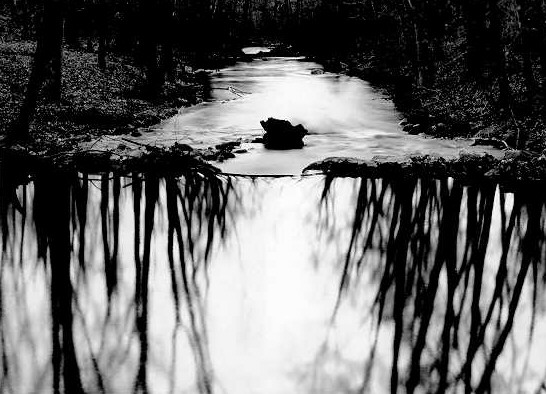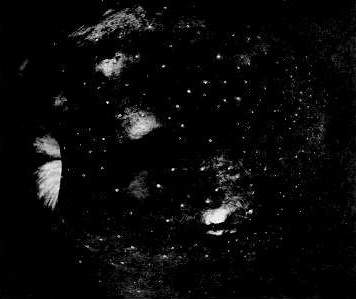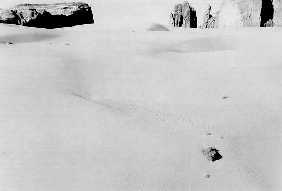The Wise Silence
Review of The Wise Silence: Photographs by Paul Caponigro, with Text by Marianne Fulton. New York Graphic Society/Little Brown & Co., 1983
 Redding, Connecticut 1968.
Redding, Connecticut 1968.
1
At age twelve, Paul Caponigro began playing the piano; at age thirteen he began photographing the New England countryside near where he was born.
Music and photography, a love of sound and place. Sounding a site, and the piano can be traced back to the ground zither: gut stretched and centered over a wooden neck planted on a stone. Centered on wood and stone, earth resonates music: the basic elements of Caponigro's photography.
The earliest picture chosen for The Wise Silence was taken when Caponigro was twenty. Nahant, Massachusetts: frothy combers roiling around rocks, a dark sea stretched out. Looking at this gruff sea we are able see that the world is only as we frame it. Alejandia Pizarnik wrote about someone who "wanted to enter the keyboard to enter inside the music to have a native land." To have a native land is be be framed. But the picture is not the page.
We agree to a format---a constellation of effects within a rigorous space---as we agree this that this picture is a reproduction of the sea, even though it doesn't comply with our sensual code. Instead, it re(as)sembles the sea on a flat plane of black and white values, "a pseudo world of limited and specific items bound together more tightly than the medieval categories of the damned (Wright Morris). A contingency, as the periphery of our vision is never secure: this is where reality stumbles into dream. "One may move everywhere freely within this enclosure without ever encountering a wall, and yet it is limited." (J. Hillis Miller) What is beyond is "out of the picture."
The next year, Caponigro, stationed in San Francisco in the Army, gave us a tree with its arms raised in the posture of surrender, a stake (knot) protruding from its chest. Rills of Edvard Munch. Feminine, as males in the military terrorize the anima of themselves. An honesty of vision that is the body of work of an artist already searching for "the intangible, the somewhere in between, the what is and what I am, the interaction between visible and invisible." The antinomy that is "reality."
After discharge from the Army, Paul Caponigro traveled home to Boston, then back to San Francisco. In 1956, four years after his picture of the Massachusetts seascape, we have an image from California that feels the cold tumescent ocean, sea-sharpened rocks, umbrated etchings swirling and curling the imagination, taken from below. With stones recalling chatoyant eyes, and ferns floating on moonlight occluding the night, the photographer strolls through dreams, snapping pictures.
All photographs dream: it is this phenomenon that fascinates, that attracts us to them. In that moment when the shutter opens, the image rushing into the camera is simultaneously taken and given. The print will reconstruct the image that the dream deconstructs. It must be this way or the world would be exhausted of form. Dreams replace reality, as reality enters the underworld of dreams. Thus the world is "humanized." Other species make the world theirs in alternative ways. And, as William Bronk cautions, "it is always a world and not the world."
The nascent work of Paul Caponigro already reveals a touch for textures and gradations, "the sparkle of tonal definition and the tissue of chiaroscuro." as Peter Bunnell put it. Like Edward Weston, who wanted "the stark beauty that a lens can so exactly render, presented without interference of "artistic effect"...no secondhand emotion for exquisite paper surfaces or color," the purist, or "straight" photographer, is idealistic, as no picture can be a clone of its subject. Photography has its own laws, its own governing body, a state within a state of illusion, its origin "always already" absent.
2
In 1957, Caponigro arrived in Rochester, New York to study with Minor White. No one was exploring the eskers of photography and religion as doggedly as White. Looking closely at the world as a threshold, a quieting inside, might yet give no clarity of vision, but a turmoil of temptations. To pursue an art form from the outside in, to apply systems, is a failure of faith. "The beautiful but undecipherable patterns occurring in nature were emphasized in the teachings of White and his followers," writes Marianne Fulton in her essay for this book, "because their very undecipherability made them susceptible to free association or "reading on the part of the viewer," Or, as Jerry Uelsmann recalls: "When I was a student of Minor White, he used to have a dictum that went 'one should photograph objects, not only for what they are, but for what else they are.'" Forgetting, on the other hand, that Andre Bazin said that "images are always about images."
After this, Caponigro's work became more abstract. Besides the suggestiveness already there. But a tension was building, a doubt. It would be years, however, before the artist began to accept the world as is, years of philosophies and motifs.
In 1959, after traveling across the country with White, Caponigro finally struck off on his own, complaining later that White was "always trying to put photography where it wasn't."

Yet, even five years later, he photographed an apple (New York City, 1964), still not allowing it to be itself, as, for instance, Cezanne did, but suggestive instead of "a galaxy in an apple." There is a picture of of just apples, unsuggestive of "what else they are," taken the same year, but he did not choose it for this collection. Though New York City 1964 is important photographically, it is those plain apples that reveal his line of insight.
At this time, Caponigro was studying drawing with Ilona Karasz, who was teaching him to "break away from what's obvious," while, Willem Nyland, her husband and Caponigro's music teacher, was urging the photographer to find freedom within his work.
Edward Weston wrote:
Nothing can be transmitted to another, unless an original problem has been felt, conceived and solved: not a trivial problem of clever decoration or personal ego, but the recording of the very quintessence and interdependence of life.
Caponigro found his "original problem," his koan, in the question, Where do images come from?--taking that fiery ball of Doubt as an image itself: an apply galaxy in his lens, or a sunflower that "reminded (him) of the forces reflected in the lower levels." Re-minding, instead of turning "our attention from chasing the lost bit of data to the empty, sinking feeling that forgetting leaves behind and which is also the mother of musing," as James Hillman counsels. As the haiku master, Matsuo Basho, wrote,
How rare is one who see
a flash of lightning
and does not think:
Life is fleeting!
3
In 1968. In the Haight-Asbury district of San Francisco,
a coffin was solemnly carried through the streets--the brief hope for
a spiritual/cultural revolution symbolically entombed. Coffin is a
tree within whose cavity reality pines away.
Caponigro was living in Connecticut, holding to the artist's lovely plat, where Robert Smithson says "remote
futures meet remote pasts." "The key is this," wrote C.G.
Jung, "we must be able to let things happen in the psyche. For us this becomes
a real
art of which few people know anything."
Redding, Connecticut. A stream seemingly flowing toward us suddenly drops away, trees reflected from its banking dropping too, upside down. Caponigro says of this picture: "I wanted to find a way to understand why I was reacting the forces which are present, although not really seen by the eye."
Still reification. But on the next two pages, facing
each other, are two extra-ordinary pictures of a forest. If we stop
to study these pictures, it is "because we carry a great chunk
of (them) within ourselves." (Frederick Sommer). Even people who
have never been off city streets carry within them engrams of the natural
world. Not only sights (I once recognized Black Forest from an untitled
snapshot, though I'd never been to Germany), but scents, sounds,
textures which our mind adds to the photographs. "The place triggers
the mind to
create the place." (Richard Hugo)
As early as 1963, Caponigro made similar pictures, but these are
more confident. There is something that is not here that is here. These trees
grow inside us.
These streams flow through our dreams like the River Styx, "preserving the
underworld
from the pain caused it by invading attitudes of life" (James Hillman).
There is no much happening here; so much growing to internal plan and external
acceptance. A world always different, not just in seasons but moments...asymmetric,
yet trued to its own
beauty.
Ground Zero for the artist who is drawn to, and draws from, the natural environment. Stood upon confidently, one's power to imagine is restored, and with it the images that "add hope to our feelings, a special rigor to our decision to be an individual, a tonus even to our physical life." (Gaston Bachelard)
4
Selection is an important statement in itself. Photographs are found images. At its best, the discriminating mind is relaxed, coming into play only later, when prints are chosen and assembled. Ever since Edward Weston declared that "The longer scale of glossy paper gives greater opportunity of producing through the values in the print whatever effect is desired," a generation of photographers, including Paul Caponigro, addicted themselves to glossy prints. Then, almost suddenly, with publication of The Wise Silence, Caponigro breaks free of this tradition.
Since the photographer was aware of the paper and gravure reproduction process to be used, the selection is significant. Along with several other pictures that appear in the present volume, Redding, Connecticut (1968) can also be seen in an earlier Aperture monograph, printed on the usual glossy paper. Besides being smaller and darker, the tonal values are spread, which loosens the images, While in the present book, the elements are more individual, etched in a vibrancy connected by a sarcentic hush, a "wise silence."
What is cunning is that, by eliminating extremes,
a center is
proposed. As Caponigro said, "It is the center that gets you to the center." Truth
is not something worked toward: it is where we begin.
As our eyes never leave their home, a slight shift in perception can tweak
realization.
How we see is who we are.
5.
In Gaelic Scotland, 'going to the stones' meant going to church. -Lucy Lippard
In Britain, dolmens, menhirs, cairns, and circles of stones, especially Stonehenge, have been photographed countless times. Caponigro became interested in them during the mid-1960s. After plans to travel through Egypt were politically aborted, he decided to photograph Celtic crosses, but quickly came under the spell of unadorned stones placed in precise runic attitudes. "When we begin to open our eyes, wrote Gabriele D'Annunzio, "we have long since committed ourselves to the invisible."

For the artist, times moves sideways like a sandcrab, so that one year in linear time before the pictures of the Connecticut woods, we have Avebury, England: A thick tree trunk in the left foreground almost covered by vines snaking over each other, forms a slithering Dantean venation struggling for a higher life, while a rotund belly-of-a-stone is alive to itself on the right side of the scene. Further away from the camera than the tree, the stone is deceptively smaller; but as perspective is subordinate to psychological size the stone assumes its actual weight, plump and balanced, complexly crated, confronting the very essence of the living tree. "Go inside a stone..." Charles Simic wrote, "perhaps it is not dark inside at all."
Caponigro photographed Stonehenge from inside the circle after a rain---splinters of sunlight focused through sarsen crotches, bisecting puddles. What interested him was not why Stonehenge was built, but that it was built---because a project constructed by a few humans is a project constructed by us all. Pyramids, roads, Stonehenge, Golden Gate Bridge, the Great Wall of China...every painting, photograph, poem, musical composition is made by us for us. We participate in the genius, though not in the skill. The living, the dead, and the yet-to-be-born, survive together in the work we all do.
Dolmens: stone tables which, Caponigro says, "float and stand with the most incredible dignity and nobility...simultaneously obeying and defying the law of gravity." Stone circles "chanting a ring of protective power for the sacred space within." Cairns "keeping the forces within." Standing stones that "seem to speak to the resurrection, and upliftment." This is how he saw them while "trying to record in the photographic image the atmosphere and magnetic power of these stone arrangements."
According to anthropologist Barry Fell, "About three thousand years ago bands of roving Celtic mariners crossed the North Atlantic to discover, and then colonize, North America." Thus Dolmens, stone circles, Celtic herms, subterranean temples apparently populate the New England countryside Caponigro photographed as a boy. "The word," wrote Edmond Jabès, "is hurled into the future in order to translate it."
6.
In 1976 Caponigro was in Japan to photograph Shinto temples and Buddhist temples, lines that sweep to an apex, squared polished wood, stone islands set in precisely raked sand. Scenes seen with gaigin eyes lovely, but out of context, standing like varnish on the anodyne surface.
It is when he looks at the countryside, with its pandemic ecological scale, like familiar music, that Caponigro begins to sense where these images come from. A Shinto temple, not much more than a shack wedded to the side of a mountain gorge, or a field of flouncing trees, both at Moto-Ise, Ayabe.

Then the world opens to visions of marl and friable plots; sheer
mesas in Utah and New Mexico; cacophony of tufa, gumbo, sinter and
clinker; epiphany of wadi, calyx,
temenos, and tyne. "With the exception of God and a stone," said I.B.
Singer, "everything is mad."
Stalking silence with the whurr of a camera, the work of an artist is ever to be begun, never to end...
(c) Artspace 1984
(c) Joel Weishaus 1984